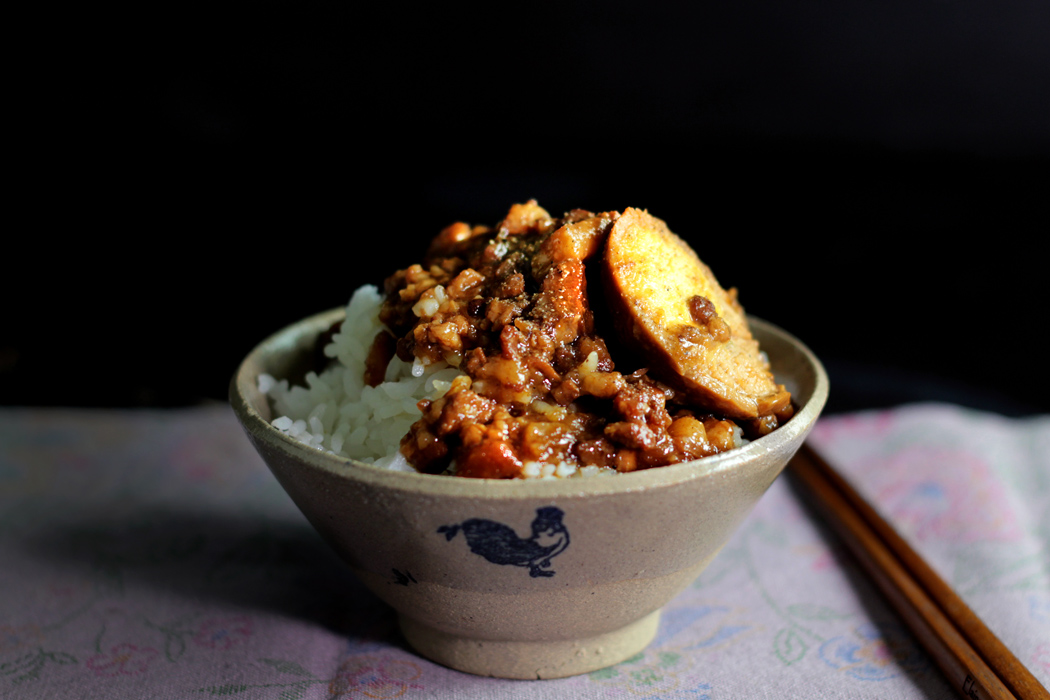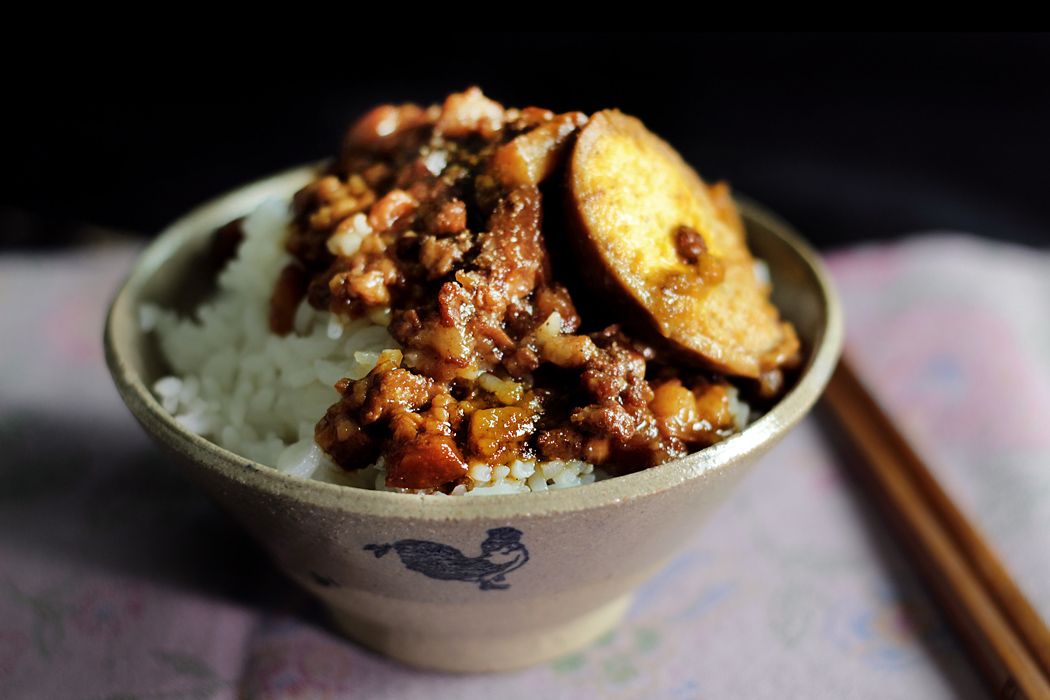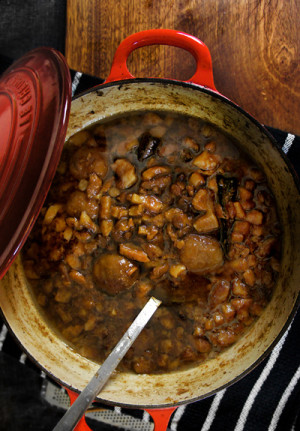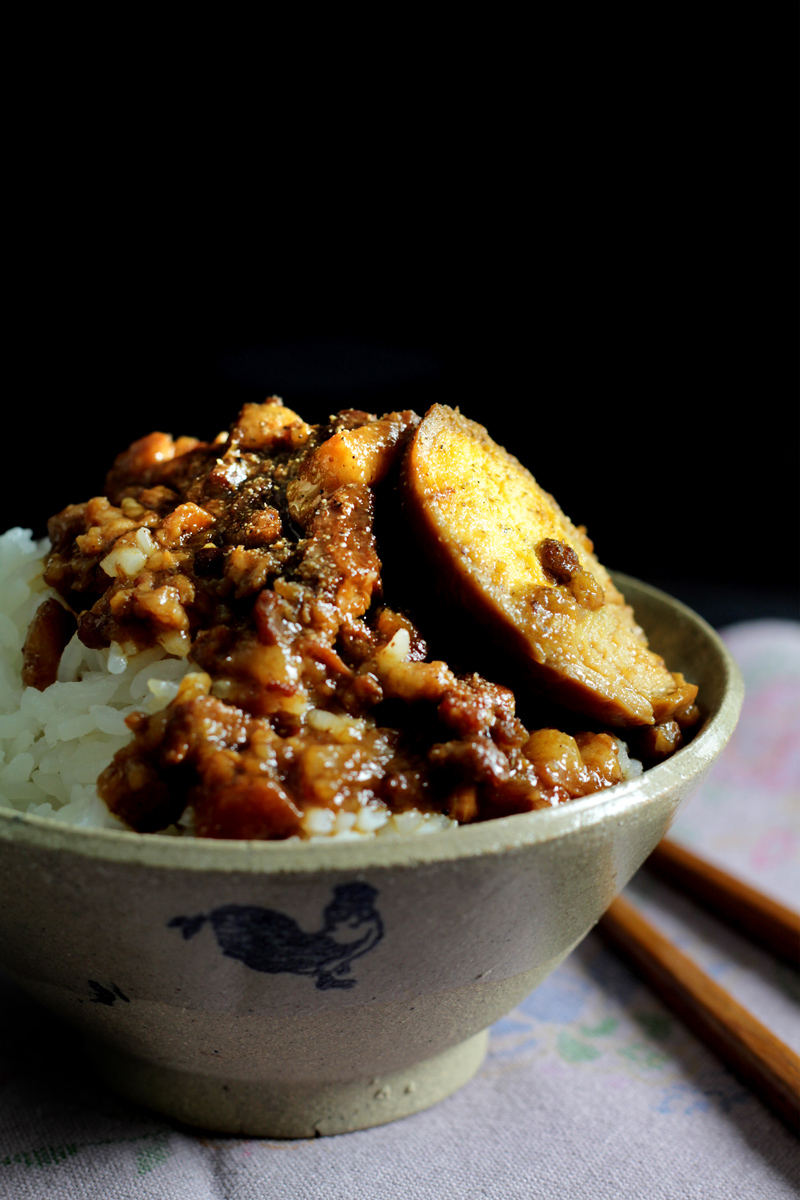TAIWAN PORK RAGU ON RICE – LU ROU FAN
“YOU MISSED OUT…
THAT JUST ISN’T FAIR”
I wrote a post called Taiwan in a pot very early on when this blog just started, when most of us haven’t actually met yet. And perhaps that’s OK. Perhaps it’s wiser to have pre-mature photographs stay buried six-feet-under the surface of blogosphere, safely and quietly, just like how I forever silenced all images of my existence before 1998… But I couldn’t help but feeling that if my pettiness to hide my food-pictures wearing braises, has caused you to miss out on something great, truly great, then that just isn’t fair. So the other night when I made this for the gazillion-th of time at home, I thought I’d give you a little shout-out.
Ladies and gents, my death-meal.
This is typically called lu-rou-fan, meaning lu-rou (braised pork) on rice (fan). It’s a generic and sometimes misleading name, because to be more accurate, it is also/should be called rou-zao-fan, meaning rou-zao (braised pork belly with fried shallots) on rice (fan). Rou-zao is a very specific, and uniquely Taiwanese thing. No matter how many adaptations or heirloom secrets are out there in every food-stall’s special recipes, it is always, always, diced pork belly braised in soy sauce and you-cong (fried shallots). The application of rou-zao is vast (as briefly described in the original post) but most-beloved-ly, is served on steamed rice.
I can’t sell you on making this if you two were never related. If you were not from, or have never been to Taiwan where this had left an impression on you, chances of you raising the slightest interest to having it on your stove is scarce. But if you were, in any way, bound to this dish by blood or memory, you should be balling with joy right now. It’s just that kind of thing.
The recipe/steps are mostly the same as previously published, except for 1 added ingredient (molasses), couple of notes/tweaks and online-sources for you-cong/Taiwanese fried shallots. Also, I have since published a post on how to make fried shallots at home, for those who are ambitious. So consider this a round-up for everything to be in one place.
So now, should I take you there? Let’s go to Taiwan.
*****
Before we start, a note on soy sauce: try to use Taiwanese brands just for the sake of keeping the margin of error down to the lowest. Base on my experience, the price of soy sauce does reflect on the quality, and although I can’t find an online-source for the specific brand I’m using, this one and this one looks promising.
Most Taiwanese stew-type dishes are done over the stove-top because ovens aren’t typical in a traditional Taiwanese kitchen. However, I would strongly advice you to use the oven in this case (if you have one of course) because it provides even/rounded heat around the pot and significantly reduces the chance of burning on the bottom of the pot, which is a highly probable outcome for this dish if you don’t keep stirring. But if you have to cook this on the stove-top, just remember that you’ll need to keep an eye on it throughout.
If you’re not having your butcher dicing the pork belly for you, you should freeze the meat until hard but workable, before cutting. Trying to dice skin-on pork belly at room-temperature would be a nightmare.
Ingredients:
- 44 oz (1250 grams) of skin-on pork belly, cut into small dices (think of dicing thick-cut bacons)
- 6 small Asian shallots, sliced
- 3 cloves of garlic, chopped
- 1 tbsp of raw/cane sugar
- 1/2 cup (135 grams) of soy sauce + 1/4 cup (66 grams) for adjusting
- 1/4 cup (45 grams) of Chinese rice wine (Japanese sake works, too)
- 1 small stick of cinnamon
- 2 tsp of molasses
- 1 tsp of ground white pepper
- 1/4 tsp of five spice powder
- 1 1/2 cup (3.5 oz/100 grams) of you-cong/Taiwanese fried shallots (or if you want homemade)
- 3 cups (710 grams) of water
- 6 large hard-boiled eggs, peeled
Preheat the oven on 310ºF/150ºC.
Sometimes if I get pork that aren’t the freshest designer-pork (like the pig just lost its life this morning at a farm called Organic Hogs), or that it was purchased from a less-than-perfectly-hygienic environment (like a traditional wet market), then I like to blanch the diced pork belly before cooking. If you have high confidence in the quality of pork you’re beholding, omit this step. To blanch: bring a large pot of water with a few pieces of ginger and scallions to a boil, add the diced pork belly and blanch for 2 min. Drain and rinse under cold water until clean of all scums. Drain well and set aside.
Heat up a Dutch oven over medium-high heat, then add the diced pork belly (blanched or fresh), sliced shallots, chopped garlic and raw/cane sugar. Turn the heat down to medium and cook until the pork starts to render out its fat, and that the sugar starts to caramelize/brown on the bottom of the pot or on the surface of the pork belly, approx 8~10 min. Add 1/2 cup of soy sauce, the rice wine, cinnamon stick, molasses, ground white pepper and five spice powder. Keep cooking and stirring until there’s good caramelization/browning on the sides and bottom of the pot, and that the liquid has almost evaporated. Add the you-cong/Taiwanese fried shallots and stir to combine, then without further frying (you-cong can easily burn), add 3 cups of water and bring to a simmer.
A lot of pork fat will float to the surface, skim off 1/2 of it and reserve (This dish should have a good amount of fat in it, but leaving too much in the pot will make it difficult to judge the water-level when the sauce is reducing. Reserving the fat allows you to adjust later.) At this point, you’ll want to adjust the seasoning with more soy sauce. Different brands of soy sauce has different saltiness, but chances are you’ll need 1/8~1/4 cup more. Poke a few holes in the hard-boiled eggs with a fork to allow flavours to penetrate, then add them into the pot. After the liquid has come back to a simmer, put the lid on and move into the oven (or if you are cooking over stove-stop, lower the heat down to low and stir once every 20 min). Cook for 2:30 to 3 hours until the pork belly is meltingly soft, and that the liquid has reduced slightly but become gelatinous. If by any chance, the liquid is reducing too fast during cooking, add a bit more water. You should have about 1/4″ of pork fat at the surface, but if there’s more, skim it off.
Spoon the rou-zao generously over hot steamed rice, with a little sprinkle of ground white pepper (I like to cook 2 parts short-grain rice with 1 part sticky rice for perfect texture).
Once it has cooled down, rou-zao can be divided into air-tight containers/bags and kept frozen until needed.





cynthia
02.24.2014at10:57 PMYou are my food soulmate.
Also, as much as I am obsessed with this dish, I never thought to make it at home for some reason — and I’m so pleased that it’s not so different from hong shao rou! I cannot wait for the next time I can pick up pork belly. Eeeeeeeee.
Belinda@themoonblushbaker
02.24.2014at11:17 PMI would make this my death dish too. However I think I need it in a steam bun. I can not get pass bread on my death bed. I am glad you bought this recipe back to life nothing like greasy braise meats on pure white carbs.
mandy@ladyandpups.com
02.25.2014at1:18 PMCYNTHIA: Although I’m sure there’s some good Taiwanese joint in Queens, I always feel like the home-version tastes better…. :P
BELINDA: Put this on anything and I’ll eat it.. haa
Jenny
02.25.2014at2:11 AMI am irrevocably addicted to lu rou fan. I order it every time my friends and I go to a Taiwanese place for dinner. So so so delicious
Lily
02.26.2014at12:54 PMLu rou fan is great, but my death meal would have to be xiao long bao. You have the most epic food blog I have ever seen and I very much identify with pre-midlife crisis.
Abbe@This is How I Cook
02.27.2014at5:47 AMSo kind of like bacon and eggs over rice-only like way better?
Anjo Angela Lim
02.28.2014at1:12 AMMandy, do you think I could use chicken instead? As I can’t eat pork.
Also, just made your english muffins today for my eggs benedicts. (Swapped out the whole wheat flour for bread flour, actually used almost all bread flour and some cake flour…as that was all I had.) Fried ’em all up in clarified butter and—DANG, woman! I knew your recipe was the one to pick. ;)
mandy@ladyandpups.com
02.28.2014at1:28 AMABBE: Bacon and eggs-who?
ANJO: Yeah I’ve never tried it but why not? Try to use dark meat ground together with its skins, because fat is quite important in this dish. And I suppose the cooking time will be substantially reduced. Glad you had fun with the English muffins!
Da
03.02.2014at11:23 PMHere in London, we use Taiwanese-approved Kikkoman soy sauce.
hungrySLIF
03.03.2014at11:00 AMGrew up on this stuff in the Philippines and there’s really nothing else out there that hits my nostalgia button quite like it. Though proper Cantonese-style sweet and sour pork would be my death-meal. Eating lu rou fan would just make me want to live longer :-)
mandy@ladyandpups.com
03.03.2014at2:16 PMHUNGRYSLIF: Oh you’re right…. never thought about it. Lu rou fan as death meal might make me even more depressed…
Lynna
03.03.2014at4:41 PMHoly crap. I just want to marry this blog. The first time I tried this dish was about 2 year ago and it`s something I`m ALWAYS looking for in the menu (of a Taiwanese restaurant) . Pork + me = happiness.
Susan
03.04.2014at11:37 PMAHHH YOUR FOOD BLOG MAKES ME SO HAPPY. I can’t wait to try all of your recipes. They are exactly the kind of food I crave for and have always wanted to replicate at home. Thanks, Mandy!
IG
03.12.2014at5:45 AMbecause of your blog, my kitchen has been overtaken by amazing too many times to count. i am here grabbing your most recent shares and i stumble upon this post… you are cookery dope, mandy :-)
mandy@ladyandpups.com
03.12.2014at1:31 PMIG, nothing makes me happier!!
Lucie
03.31.2014at9:23 PMI don’t have the brand of rice wine you’ve listed, but I do have sake and Shaoxing – in your recipe you say that sake works as a substitute, though a YouTube tutorial also using the Taiwan rice wine states Shaoxing as a substitute. Is one more suitable than the other, or is the difference pretty negligible?
Going to try making this dish tonight. Super excited! Your blog has inspired me to get into Taiwanese cuisine, it’s so beautiful :)
mandy@ladyandpups.com
03.31.2014at10:34 PMLucie, I would say that sake is a better substitute of Taiwanese rice wine. Shooting has a stronger flavour, not as “neutral”. If you have both sake, rice wine and shaoxing, and you take a sniff, you’ll see what I mean. I hope it turns out great!
mandy@ladyandpups.com
03.31.2014at10:37 PMSorry in the second sentence I meant shaoxing, not shooting… Urgh
Lucie
04.04.2014at1:32 PMI made this using sake! My brother and I liked it a lot, but this might have been because it tasted almost exactly like thit heo kho to us. Are you familiar with that dish? I’ve never had Lu rou fan before now, so I can’t tell if this is the intended result or not D:
mandy@ladyandpups.com
04.04.2014at2:07 PMI looked at it on Google, Vietnamese braised pork? I’ve never had it so I don’t know what it tastes like either! :P Lu rou fan should carry a strong aroma of fried shallots, which I’m not sure if is in the Vietnamese dish. But I guess both being soy sauce-based dishes with pork belly and egg, it will overlap in flavours.
Alex
04.08.2014at6:58 AMI’ve been looking for a great lu rou fan recipe, and yours looks crazy authentic. Just wondering – how would star anise or bay leaf change the flavor of this? A lot of the other recipes I’ve found use one or both, but they also tend to be much shorter and simpler, too. Is it a convenience thing, or regional differences?
Superb photos, by the way! Looking forward to making this :-)
mandy@ladyandpups.com
04.08.2014at1:15 PMALEX: lu-rou-fan is one of those street-foods that have a lot of varietions and “secret recipes”. The only constant is the pork belly, soy sauce, and fried shallots (you-cony). Some people uses star anise or bay leaf for aromatics, whereas I’m using cinnamon stick and five spice powder (which contains star anise). It really all depends on your liking. Regional wise, the Northern lu-rou-fan tends to be saltier VS Southern ones are sweeter. I’m a “northern Taiwanese” and I don’t like it sweet. I believe most lu-rou-fan maker would argue that the quality of the fried shallots is the most important thing, using Asian shallots (more slender and oval than round) would be recommended if you’re frying your own. Good luck!
Melissa
04.08.2014at11:29 PMHi! I had been eyeing this recipe for weeks, and tonight, finally made this for my Taiwanese husband, and he LOVES it! I love your blog and am looking forward to making more of your recipes. Thanks for posting this. It was AWESOME :)
Beverly
07.29.2014at7:31 PMHi Mandy,
Made this tonight and it was a great success. Why are fried shallots so crucial though? I added them in to be safe but just wondering why it plays such a big part in the recipe. Anyway everyone loved it and thinking about what else to do with the extra sauce!!
mandy@ladyandpups
07.29.2014at7:41 PMBEVERLY: The fried shallot is what makes this dish “Taiwanese”. The flavour and aroma of you-cong/fried shallot is familiar to everyone who grow up in Taiwan. Without it, it’s just soy sauce pork belly.
Vera
10.13.2014at8:23 AMthank you so much for this recipe. my friend recommended your blog and I love it! If you wouldn’t mind, could I reference you as a food blogger on my own? I’m sure people would love to have access to this and other recipes!
mandy@ladyandpups
10.13.2014at1:40 PMVera, yes of course! Thanks for sharing!
Rose
11.17.2014at12:57 PMI made this tonight for a community potluck here in Washington D.C. I have to say, it was amazing. There were no leftovers. Even the skinny picky girl went back for thirds. I subbed sherry for the rice wine and used dark soy sauce instead of molasses. Also, either I made particularly lean pork belly or I didn’t cook it enough in the beginning to render out the fat, because I never had a layer of oil on the surface and the dish didn’t taste particularly oily (rich, for sure though). Gonna keep this one on the books. Thanks!
Grace
11.27.2014at3:28 AMQuick question, how many servings does this make?
mandy@ladyandpups
11.27.2014at1:31 PMGrace: If each person gets 1 regular bowl, you can serve 10 no problem.
Kris
02.11.2015at12:39 PMCan you take a picture of the soy sauce you use? Thanks!
samantha
03.15.2015at10:29 AMAwesome recipe! I used whatever meats I had on hand so mine was a mix of ground pork, diced bacon and diced tender beef chuck. Used organic soy sauce and added a couple of rock sugars. The instructions were so precise you can’t go wrong with making this successfully. Served over rice and some baby bok choi.
samantha
03.15.2015at10:41 AMalso topped it with a fried egg sunny-side up instead of going through the trouble of hard-boiling eggs
mandy@ladyandpups
03.16.2015at4:36 PMSamantha, glad you enjoyed it!!! It was time consuming but well worth it.
Katy Love
04.13.2015at3:13 AMAnother staple in my recipe book. Rou zao sauce is almost like a condiment in Taiwan. It can be served with rice, noodles or on its on. After skimming the fat off, I keep the reserves as lard. Nothing beats pork fat lard.
Lynette K
05.26.2015at11:42 AMHi, great site, great photos and great recipes! Many thanks!! I got hooked and am in the process of going thru’ your past posts :)
I have a question for this recipe – can I replace the molasses with golden syrup or something else?
Thanks!
mandy@ladyandpups
05.26.2015at12:34 PMLynette, molasses brings a deep flavour that golden syrups doesn’t. If you don’t have molasses, just omit it, and adjust the sweetness with brown sugar.
Lynette L
06.28.2015at6:35 PMThank you for sharing your recipe! Just made this for dinner and everyone is currently in a food coma (^ω^)
Angela
04.01.2016at8:40 PMSpeechless.
I loved this dish. I love you.
As delicious as I had hoped and more.
I also didn’t get a layer of fat on top. Even without skimming at all, it was fine and not very oily. Maybe only one tweak next time. I’ll extra-extra poke those eggs to ensure max flavour seepage :)
Steve
07.10.2017at5:45 AMI have tried this dish using recipes from multiple sources. This is the one that made my Taiwanese mother-in-law start to like me.
mandy@ladyandpups
07.10.2017at12:02 PMSteve, hahahaa you made me laugh! Glad to hear that :)
Sarah
07.28.2017at2:58 AMCan you make this in a slow cooker and use ground pork? I’ve seen different recipes using pork belly and ground pork. Just wondering if you could combine both types of meats to make it extra flavorful?
mandy@ladyandpups
07.28.2017at12:22 PMSarah, general wisdom is that this dish needs the fat and skin from the belly to be rich and gelatinous. You can use ground pork but the texture will of course be different. I’ve never used a slow cooker before so I don’t know. If it works let me know :)
Dave
07.28.2017at5:17 PMI’ve had ground pork on rice. Google lu to fan recipes. Tends to be stickier.